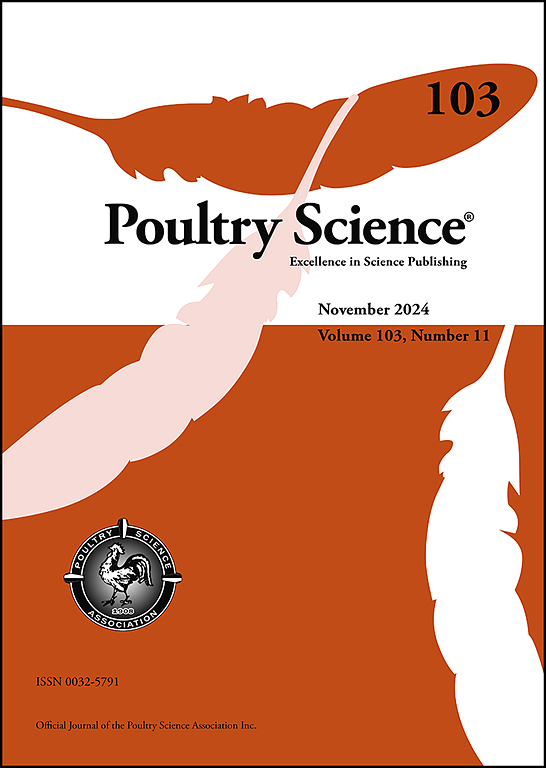膳食缬氨酸影响日本鹌鹑精子参数和睾丸组织学
IF 3.8
1区 农林科学
Q1 AGRICULTURE, DAIRY & ANIMAL SCIENCE
引用次数: 0
摘要
缬氨酸是一种必需氨基酸,参与各种生理和代谢活动。本研究旨在探讨日粮中不同缬氨酸水平对成年雄性日本鹌鹑生殖性能的影响。选用40只14-24周龄雄性鹌鹑雏鸡,采用完全随机设计,分5个处理(饲粮中缬氨酸含量分别为0.65、0.75、0.85、0.95和1.05%),4个重复,每个重复2只,试验期35 d,预试期14 d。每周采集精液,分析其特征。然后屠宰这些鸟,并对睾丸样本进行组织学分析。结果表明,不同缬氨酸水平对睾丸体积、长度和相对重量均无显著影响,但睾丸直径随饲粮缬氨酸水平的增加呈线性和二次曲线递减趋势(p <;0.05)。随着饲粮缬氨酸的增加,精子的总活力和进行性活力降低(p <;0.05)。异常精子形态随饲料中缬氨酸水平的增加而增加,处理间差异显著。饲粮中不同缬氨酸水平显著影响睾丸精小管上皮高度、小管直径和数量以及小管分化指数;但对生精指数无明显影响。研究结果表明,当饮食中缬氨酸含量超过0.75%时,成年鹌鹑的睾丸体积和直径以及精子的质量特性都会受到不利影响。在这个领域进行进一步的研究是明智的。本文章由计算机程序翻译,如有差异,请以英文原文为准。
Dietary valine affects Japanese quails’ sperm parameters and testis histology
Valine is an essential amino acid that participates in various physiological and metabolic activities. The objective of the present study was to investigate the influence of different valine levels in the diet on the reproductive performance of adult male Japanese quails. Forty male quail chicks (14-24 week old) were employed in a completely randomized design with 5 treatments (0.65, 0.75, 0.85, 0.95, and 1.05 % valine in the diet), 4 replicates and 2 birds in each replicate over a period of 35 days following a 14-day adaptation period. Semen was collected weekly, and its characteristics were analyzed. The birds were then ethically slaughtered, and histological analyses were performed on testicular samples. Results showed that the different valine levels had no significant effect on testicle volume, length and relative weight, although testicle diameter tended to decrease with increasing valine level in the diet in a linear and quadratic manner (p < 0.05). The total motility and progressive motility of sperm decreased with an increase in dietary valine (p < 0.05). Abnormal sperm morphology increased with increasing valine level in the diet and the difference between treatments was significant. Different valine levels in the diet significantly affected the height of seminiferous tubule epithelia, diameter and number of tubules as well as the tubular differentiation index of the testis; but the spermatogenic index was not affected by the treatments. The findings of the study indicate that when valine levels in the diet exceed 0.75 %, there is an adverse impact on testicular volume and diameter, as well as the qualitative properties of sperm in adult quails. It is advisable to pursue additional research in this area.
求助全文
通过发布文献求助,成功后即可免费获取论文全文。
去求助
来源期刊

Poultry Science
农林科学-奶制品与动物科学
CiteScore
7.60
自引率
15.90%
发文量
0
审稿时长
94 days
期刊介绍:
First self-published in 1921, Poultry Science is an internationally renowned monthly journal, known as the authoritative source for a broad range of poultry information and high-caliber research. The journal plays a pivotal role in the dissemination of preeminent poultry-related knowledge across all disciplines. As of January 2020, Poultry Science will become an Open Access journal with no subscription charges, meaning authors who publish here can make their research immediately, permanently, and freely accessible worldwide while retaining copyright to their work. Papers submitted for publication after October 1, 2019 will be published as Open Access papers.
An international journal, Poultry Science publishes original papers, research notes, symposium papers, and reviews of basic science as applied to poultry. This authoritative source of poultry information is consistently ranked by ISI Impact Factor as one of the top 10 agriculture, dairy and animal science journals to deliver high-caliber research. Currently it is the highest-ranked (by Impact Factor and Eigenfactor) journal dedicated to publishing poultry research. Subject areas include breeding, genetics, education, production, management, environment, health, behavior, welfare, immunology, molecular biology, metabolism, nutrition, physiology, reproduction, processing, and products.
 求助内容:
求助内容: 应助结果提醒方式:
应助结果提醒方式:


